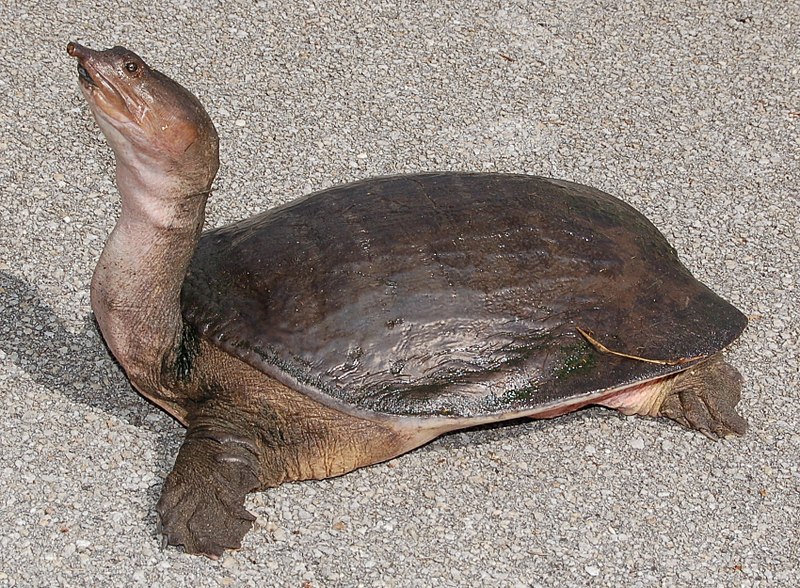The world’s 24 species of Softshell Turtles (Family Trionychidae) depart radically from the typical turtle body plan, and their behavior holds many surprises for those familiar with “normal” turtles. In Part 1 of this article we looked at their natural history and diet, and discussed the basics of captive care. I also relayed some of the difficulties inherent in working with these delicate creatures – difficulties that resulted in the loss of some huge and rare individuals of several species. I hope you enjoy the following Softshell observations and stories. Read More »
Category Archives: Turtles & Tortoises
Feed SubscriptionThe Natural History and Captive Care of the Softshell Turtles – Part 1
 Softshell Turtles caught my attention early and remain great favorites of mine all these years (decades!) later. I’ve had a long history with the group – I raised Smooth Softshell hatchlings as a child, dove with huge Florida Softshells in southern canals and was eventually lucky enough to work with the immense Narrow-Headed and Bibron’s Giant Softshells. Today I’d like to introduce this most unique turtle family. Read More »
Softshell Turtles caught my attention early and remain great favorites of mine all these years (decades!) later. I’ve had a long history with the group – I raised Smooth Softshell hatchlings as a child, dove with huge Florida Softshells in southern canals and was eventually lucky enough to work with the immense Narrow-Headed and Bibron’s Giant Softshells. Today I’d like to introduce this most unique turtle family. Read More »
Red-Eared Sliders Out-Compete Native European Turtles
 Red Eared Sliders (Trachemys scripta elegans) have been introduced worldwide and are believed to negatively impact many species. However, direct evidence concerning their affect on other turtles is scarce. A recent study involving Sliders, Spanish Terrapins (Mauremys leprosa) and European Pond Turtles (Emys orbicularis) has shed some light on the subject.
Red Eared Sliders (Trachemys scripta elegans) have been introduced worldwide and are believed to negatively impact many species. However, direct evidence concerning their affect on other turtles is scarce. A recent study involving Sliders, Spanish Terrapins (Mauremys leprosa) and European Pond Turtles (Emys orbicularis) has shed some light on the subject.
Hardy Invaders
It’s easy to imagine that introduced Red Eared Sliders would create problems for native European turtles. They are larger than many species favoring similar foods, breed rapidly, adjust well to human presence, and are very aggressive in the pursuit of food and basking sites.
I have noticed that Eastern Painted Turtles have declined in several habitats now occupied by Sliders, but am basing this on observation only, not study. Others voice the same concerns, but again have been unable to document just what, if anything, the Sliders are doing to nudge-out the natives. Read More »
Egg Retention (Dystocia) in Turtles – the Problem and Some Solutions – Part 2
 Please see Part 1 of this article for general information on retained-egg syndrome and the provision of suitable nest sites for captive turtles.
Please see Part 1 of this article for general information on retained-egg syndrome and the provision of suitable nest sites for captive turtles.
Creating an Acceptable Nest Site
Gravid turtles can be maddeningly choosy when it comes to nest site selection – even when presented with what appears to be perfectly “natural” situation, some females refuse to “appreciate” our efforts.
Moisture usually attracts nesting females, and in some cases heavy misting, to simulate rain, is useful (in NYC, I’ve noticed that a great many Common Snapping Turtles nest on the first rainy night in June). Read More »
The Painted Turtle – Notes on Captive Care and Natural History
This article is one of a series in which I plan to provide a brief introduction to both popular and rarely-kept amphibians, reptiles and invertebrates. I’ll cover such topics as unique habits in the wild, common concerns in captive care, pet pros and cons, husbandry tips and so forth. Detailed care articles will follow…until then, I would enjoy receiving your questions and comments. Today we’ll take a look at the most widespread of all North American Chelonians, the Painted Turtle (Chrysemys picta). Read More »
 That Reptile Blog – Reptile, Amphibian and Exotic Pet Care and Information
That Reptile Blog – Reptile, Amphibian and Exotic Pet Care and Information
